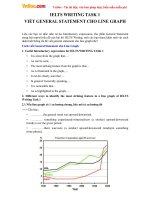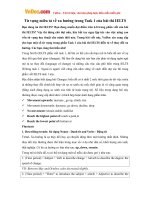TASK 1 WRITING line graph IELTS testbuilder rail network
Bạn đang xem bản rút gọn của tài liệu. Xem và tải ngay bản đầy đủ của tài liệu tại đây (2.68 MB, 4 trang )
Writing
Academic Writing
60 minutes
WRITING TASK 1
You should spend about 20 minutes on this task.
The graph below shows the number of passenger railway journeys made in Great Britain
between 1950 and 2004/5.
Summarize the information by selecting and reporting the main features,
and make comparisons where relevant.
Write at least 150 words.
I •.•
_,
.,
~I!
Millions
1,250~-------------------------------------------------------------
National rail network
1,000 --J.l~~J:-----':=\---------------------~
750~--------~--------------~----~~~--~~~~~~~---------
London Underground
500~----------------------------------~~-----------------------
250-r----------------------------------------------------------Light rail & metro systems
o
,--""'-------
_/
-
•
-r-----------,-----------------.----------=--~~~~----------_,----------------,
1950
1960
1970
1980
Passenger railway journeys, Great Britain
Before you write your answer to Task 1, go on to pages 31-33.
1990/91
2004/05
r------------------------------------------------------------------------------------------,
,
,
Further practice for Writing Task 1
,
I
Language to describe movements in
graphs
to plunge
1
to rise (gradually)
I
I
I
I
I
I
I
I
I
to soar
Look at the list of verbs opposite and match them
to the parts of the graphs A-I.
I
,,
I
to fluctuate
r-------------------------,
to hit/ reach a peak
: to fall
to dip
!
: Example
A
.-------------------------~
to bottom out
to remain flat
A
x
·······x········x
.....•.,
B
- - - - - -
...
--
••••• ,
E
.•.
~..•.
I
.. .
.
••••
G
I
D
F
••••
.
H
•
-~,
,
,
,
'JIi..-
I
,
.-
••••
,
~.
~
.
~
,
,
,
,
,
,
,
,
•
-
•
•
:. -----------------------------------------------------------------------------------------I
~-----------------------------------------------------------------------------------------_.
•
'·...
f~
j
.:
:2
I
I
I
I
I
I
I
I
I
Complete the following sentences using words
from 1above as either verbs or nouns in the
correct form.
a
Student numbers
wildly, but
the trend was clearly upward.
b
There was a gradual
student numbers, followed
drop.
I
I
I
I
I
I
I
I
I
I
I
I
I
I
Student numbers
a peak
towards the end of the period and then
declined steadily.
d
There was a steady
in student
numbers, after which they fell and then
bottomed out.
I
I
I
I
s.,
'"
"I
"I
:3
I
I
I
I
I
I
I· ,••,
I
I
I
I
Generally
e
The number of students
then they began to climb again.
f
After plunging
numbers
g
After an initial rise, student
......................to a new low.
speaking,
all three networks
trend an upward show.
e
By 2004/05,
the National
rail network
a high had reached of billion around 1.1
passenger
e
I
I
I
I
I
in
by a sharp
b
journeys.
d
Moreover, journey numbers for the
London Underground
showed a
similar pattern 500 from falling about
approximately 700 million to million.
e
The graph illustrates passenger journeys
on systems three in Great railway Britain
between 1950 and 2005.
f
Both systems exceeded the billion
passenger journey mark, with the 1980s
and the early 2000s the most increases
, but
sharply, student
out.
numbers
Match the following verbs with the correct verb
from 1above.
.-------------------------~
go
= fClLL, IiL-p
~-------------------------.
: Example
I
I
I
I
I
I
I
I
Iiowll\,
decline
rocket
plummet
decrease
increase
jump
I
I
I
I
noticeable witnessing.
I
I
I
I
I
I
I
I reach a high
L---
level off
~
I
I
:4
I
I
I
I
I
I
I
I
I
I
I
Look at the graph in Task 1 on page 30. Correct
the sentences below by rearranging the words in
italics.
a
•...•...•.....•.•..•....•••...•....•......••....•...•.............•..••..•...•.•...•..•.•.
I
I
The light railway
I
I
g
and metro systems
have as many did not as passenger journeys
the other two networks.
that the for the numbers
Underground London match and at times
exceed the national figures.
It is noticeable
.....•.•••.•...•.•••.•••••••••••..••.•..••••..•....•......•.••.••....•..•..•..•.•.•.•.....
I
I
I
I
I
I
I
I
I
I
I
I
I
I
......................••.......................................•....•.....................
I
I
,
I
h
The most striking characteristic is that
the journey numbers for the National
rail network Underground the correspond
to those for London.
I
I
I
I
,
I
I
I
I
I
I
I
•••.•......•.••..•...••••.........•••......•..•••....•....••.•..•......•.•.•..............
I
,
I
I
•...•.•.•...............••..........•...........••..........••.•.•.......••...............
~------------------------------------------------------------------------------------------~
I
I
I
I
5
Decide which sentences a-h in 4 above are:
summarizing sentences
ii
comparisons
iii an introduction
iv striking features
Note that some sentences may be included in
more than one category.
6
Now write your own answer to Task 1on
page 30. When you have finished writing, use
questions a-g below to check your answer.
a
Is the text at least 150 words?
b
Is the text divided into paragraphs?
c
Does the introduction contain words
and phrases that are different from the
question?
d
Has the text summarized the
information by selecting and reporting
the main features and made relevant
comparisons?
e
Is anything missing?
f
Does the text avoid repetition of words
and grammar?
g
Are there any mistakes?
I
I
I
I
I
I
I
I
I
I
I
7
,
,
Now look at the following model answer for
Task 1 and answer questions 6 a-g again.
The graph provides information
about how many trips were made by
passengers on three railway systems
in Great Britain between 1950 and
2004/5.
I
I
I
I
I
I
I
,
I
I
,
:;
I
I
I
~
,
It is clear that the trends for all three
networks are upward with the most
striking feature being the similarity
between the National rail network and
the London Underground. For example,
numbers for the former fell from
approximately one billion passengers
in 1950 to about 750 million in the
early 1980s. Likewise, the London
Underground experienced a parallel, but
less pronounced, decline over the same
period (from approximately 700 million
to about 500 million). Thereafter, both
followed a very similar pattern as they
climbed towards the billion passenger
mark, with the 1980s and the early
2000s seeing the sharpest increases.
The National rail network reached a high
of approximately 1.1billion passenger
journeys in 2004/05.
By comparison, after their introduction
in the 1960s, the light railway
and metro systems carried fewer
passengers than the other two
networks, no more than around ten
million over the nrst 15 years. However,
in 1980 the number of journeys made by
passengers picked up, reaching nearly
200 million in 2004/05.
(Word count: 188 words)
._-----------------------------------------------------------------~-----------------------~
'
Now check your answers to this section and compare your Task 1 answer with the model above and
authentic student answer on page 127. Then do Task 2 on page 34.
I
I
I
I
I
I
I
I
I
I
I
I
I
I
I
I
I
I
I
I
I
I
I
•..
'
I
I
I









